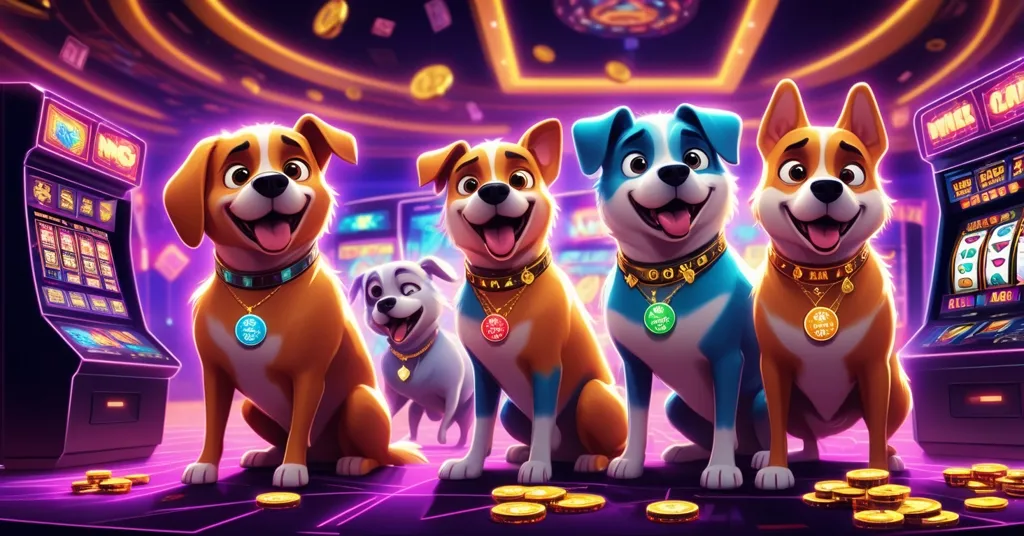Top 3 Meme Coins After Shiba Inu: Little Pepe, Dogecoin, and Bonk Under the Spotlight

Top 3 Meme Coins Capturing the Attention of Investors Who Struck Gold with Shiba Inu
The Shiba Inu (SHIB) frenzy of 2021, where some savvy or just plain lucky investors turned a mere $100 into millions, still fuels dreams in the crypto wild west. That intoxicating rush of catching a meme coin rocket is driving fast-moving speculators to hunt for the next big score. While Shiba Inu remains the poster child for meme coin mania, eyes are now on fresh contenders like Little Pepe ($LILPEPE), alongside old guards like Dogecoin (DOGE) and Solana’s chaotic darling, Bonk. Could these tokens replicate SHIB’s insane run, or are they just speculative bubbles waiting to pop? Let’s dig into the hype, the tech, and the hard realities of this high-stakes gamble.
- Little Pepe ($LILPEPE): A newcomer with a presale raking in millions, touting a custom Layer 2 chain for meme tokens and bold promises of utility.
- Dogecoin (DOGE): The original meme coin, still clinging to relevance but slammed for stagnant innovation.
- Bonk: A Solana-based wild card with raw community energy, though its staying power is anyone’s guess.
Meme Coins: Internet Jokes or Jackpot Tickets?
For those new to the game, meme coins are cryptocurrencies born from internet humor, viral trends, or cultural gags—think dog pictures or snarky hashtags. They often lack real-world utility, thriving instead on community buzz and social media frenzy. Their prices can spike 100x overnight or crater just as fast, making them the ultimate high-risk, high-reward play in crypto. The investors who hit the jackpot with SHIB during its 2021 peak aren’t sitting pretty—they’re chasing that adrenaline again, fueled by nostalgia, fear of missing out (FOMO), and a nose for cheap entry points. With Bitcoin stumbling (down from a high of $73,750 in March 2024 to around $64,000 recently) and altcoin interest cooling since mid-2024, meme coins offer a speculative thrill for those willing to bet against the bearish gloom.
But let’s not kid ourselves. Meme coins are often a digital casino, where the house—be it shady developers or market manipulators—usually wins. Beyond the shiny promises, rug pulls (where developers abandon a project after pocketing funds) and pump-and-dump schemes are rampant. Past disasters like the Squid Game token, which collapsed in 2021 after a blatant scam, are a grim reminder of the risks tied to meme coin investments. So while we’re unpacking the hype around these three tokens, keep your skepticism dialed up. We’re here to champion decentralization and disruption, but not at the cost of blind faith or reckless gambling.
Little Pepe ($LILPEPE): Hype Machine or Hidden Gem?
Topping the list of new hopefuls is Little Pepe ($LILPEPE), a project making waves with its ongoing presale. Sitting at Stage 5 with a token price of $0.0014, it’s moved over 4 billion tokens out of 4.26 billion available, raising a hefty $5.19 million. The price is set to tick up to $0.0015 in Stage 6, a structure that rewards early birds while keeping the barrier low for retail players. On the surface, it’s classic meme coin bait—dirt-cheap entry with dreams of a moonshot. But Little Pepe isn’t just banking on vibes; it’s pitching a full ecosystem that could set it apart.
Unlike SHIB or DOGE, which piggyback on existing blockchains like Ethereum or Litecoin, Little Pepe is crafting its own zero-tax, EVM-compatible Layer 2 chain tailored for meme tokens. If you’re scratching your head, a Layer 2 chain is like an express lane built over a main blockchain highway—designed to cut transaction fees and speed up trades, solving the scalability headaches that plague networks during hype cycles. “Zero-tax” means no extra cuts taken on trades, letting users keep more of their gains during frantic meme coin pumps. Being EVM-compatible (Ethereum Virtual Machine) means it can play nice with Ethereum-based tools and smart contracts, widening its developer appeal.
The project also boasts sniper bot protection—basically, defenses against automated trading bots that snipe deals before regular investors can blink, a common frustration in presale frenzies. Add to that a launchpad for new meme projects, NFT integration for digital collectibles, DAO voting (where the community calls the shots on decisions via a decentralized system), and future cross-chain compatibility (to link with other blockchains), and you’ve got a sandbox that’s more than just a token. Oh, and they’re dangling a $777,000 giveaway for presale participants, with 10 winners pocketing $77,000 in $LILPEPE tokens each. The buzz from investors, including discussions on platforms like Reddit about Little Pepe’s presale, seems clear:
“Little Pepe is checking all the boxes: low entry price, solid tech, and a real roadmap.”
But let’s slam the brakes on the hype train. Presale success doesn’t guarantee post-launch delivery. Meme coin history is a graveyard of broken promises, and Little Pepe’s anonymous team—despite claims of backing from blockchain pros who’ve scaled big meme projects—screams potential scam. Without transparency, this could be another rug pull waiting to fleece eager degens. And even if legit, building a Layer 2 chain isn’t child’s play—adoption hurdles and competition from established solutions like Arbitrum or Optimism could sink it before it swims. For now, it’s a tantalizing bet, but don’t mortgage the house just yet. If you’re curious about its tech, check out this technical analysis of Little Pepe’s Layer 2 features.
Dogecoin (DOGE): Relic or Still Relevant?
Shifting gears to Dogecoin (DOGE), we’re looking at the granddaddy of meme coins, birthed in 2013 as a literal joke but morphing into a cultural juggernaut, thanks in part to Elon Musk’s meme-lord tweets. DOGE still sits pretty on every major exchange, with a market cap that dwarfs most newcomers. Its staying power is real—plenty of SHIB millionaires likely rode DOGE’s early waves, like its 2021 surge when it hit $0.74 before tumbling back. Yet, the critique is brutal and deserved: Dogecoin hasn’t innovated in a dog’s age. It’s stuck on a third-party blockchain with no compelling roadmap to evolve.
For speculative traders chasing SHIB-style explosions, DOCGE feels like a dusty relic—more a nostalgia trip than a growth play. Its rabid fanbase and the odd Musk tweet could still spike its price, but compared to shiny new toys like Little Pepe, DOGE is your grandpa’s flip phone in a world of foldable screens. Even juxtaposed with Bitcoin’s battle-tested resilience as a store of value, DOGE’s volatility and lack of purpose stand out as a weaker case for long-term holding. It’s safe, stale, and unlikely to deliver the 100x returns these investors crave. For a deeper dive into its challenges, explore this analysis of Dogecoin’s innovation struggles. Still, its legacy keeps it in the game—for now.
Bonk: Solana’s Wild Card of Chaos
Rounding out the trio is Bonk, a Solana-based meme coin that stormed in with explosive airdrops and a community vibe that screams, “We’re not here for tech, we’re here for the lulz.” Solana, if you’re new, is a high-speed blockchain with dirt-cheap fees, making it a playground for meme coin experiments. Bonk’s charm is its raw, unpolished energy—viral marketing, grassroots hype, and a self-proclaimed “meme coin for intellectuals” tag that’s as sarcastic as it gets. It’s woven into Solana’s ecosystem for payments, NFTs, and even crypto casino gambling, while a token-burning mechanism (destroying coins to create scarcity) aims to prop up its price.
Recent market data shows Bonk’s rollercoaster nature: up 11.17% in a 24-hour burst but down 9.42% over a week, as per trackers from late 2024. Its DAO—short for Decentralized Autonomous Organization, where community members vote on project moves—encourages participation and adds liquidity to Solana’s decentralized exchanges (DEXs, platforms for trading without middlemen). Social media sentiment, especially on Twitter and Reddit, paints Bonk as a darling of the degen crowd, with tweet volumes spiking during airdrop events. For more on this, see the community hype surrounding Bonk on Solana. But for all its spark, Bonk’s long-term value is a giant question mark. Is this a fleeting fad or a sleeper hit? Investors chasing SHIB-level gains are intrigued but cautious, knowing hype can vanish faster than a Solana transaction. Check out this update on Bonk’s growth potential for a deeper look.
The Ugly Truth About Meme Coins
So why are these SHIB-style speculators piling into Little Pepe, DOGE, and Bonk? It’s a toxic mix of early-entry obsession, community fervor, and the hunt for anything with momentum or a half-decent plan. SHIB has evolved into a more serious project with DeFi plays like Shibaswap, shedding some of its wild meme roots, while DOGE feels like a museum exhibit. Fresh faces like Little Pepe tempt with untapped potential, especially through presale conviction and juicy perks. Bonk taps the chaos-loving, quick-flip mindset, boosted by Solana’s speed. Yet, let’s cut the crap: meme coins are a speculative swamp. Most lack intrinsic value, are ripe for manipulation, and live or die by social media whims. Influencers shilling 100x returns on Little Pepe or Bonk? That’s usually baseless garbage meant to pump and dump on unsuspecting bag-holders.
Regulatory storm clouds are brewing too. Governments worldwide are tightening the screws on crypto, and meme coins are easy targets. The U.S. SEC has flagged unregistered securities risks, while some regions mull outright bans on these tokens due to fraud concerns. Even in a sluggish market where Bitcoin and altcoins struggle, the lure of outsized gains keeps the gamblers coming. But investing in meme coins is like playing roulette with internet memes as your chips—one spin might crown you, the next leaves you broke and memeless. If you’re looking for inspiration on massive gains, take a look at these top meme coins that turned small investments into millions.
Meme Coins and the Bigger Picture of Decentralization
Zooming out, meme coins aren’t just digital lottery tickets—they’re a cultural force in crypto. They often serve as gateways for everyday folks to explore decentralization, embodying community power and a middle finger to traditional finance, even if half the time they’re just a prank gone viral. Little Pepe’s stab at a purpose-built ecosystem hints at a pivot toward utility, but whether it dodges the traps of its predecessors is a coin toss. Bonk’s grassroots madness and DOGE’s stubborn survival show the spectrum of what meme coins can be: fleeting buzz, lasting icons, or maybe something more. Unlike Bitcoin, which pushes for financial sovereignty with a decade of scars to prove it, meme coins often flirt with pure chaos—yet both challenge the status quo in their own messy way.
Fast-moving investors are rolling the dice on all three, hoping to bottle lightning once more. They’re drawn by the democratized access to wild opportunities, a hallmark of crypto’s disruptive ethos we cheer for. But the pitfalls are glaring, and we’re not here to peddle fairy tales. As champions of effective accelerationism—pushing tech and freedom forward at full throttle—we see meme coins as both a spark for adoption and a potential stain on crypto’s credibility if scams keep piling up. So tread carefully, keep your eyes peeled for red flags, and don’t let the memes blind you to the math.
Key Takeaways and Burning Questions on Meme Coins
- What makes Little Pepe ($LILPEPE) a magnet for investors seeking SHIB-style gains?
Its rock-bottom presale price of $0.0014, a dedicated Layer 2 chain with zero-tax transactions, and extras like NFT integration and DAO voting lure risk-takers, though unproven execution remains a massive gamble. - Does Dogecoin (DOGE) still hold appeal for speculative traders?
DOGE clings to relevance with a huge community and exchange presence, but its lack of fresh ideas makes it a dull bet compared to riskier, newer tokens. - Can Bonk sustain its Solana-fueled hype, or is it doomed to fade?
Bonk’s community spark and Solana integrations fuel short-term excitement, but price swings and shaky long-term value cast doubt on its endurance. - What are the biggest dangers of jumping into meme coin presales?
Rug pulls, anonymous teams, and pure speculation are rampant—projects like Little Pepe could vanish overnight, leaving investors with nothing but regret. - Why do meme coins thrive even in a bearish crypto market?
Low entry costs, cultural allure, and the dream of massive returns keep speculators hooked, despite broader market woes and looming regulatory crackdowns. - How do meme coins tie into crypto’s push for decentralization?
They lower the barrier for retail investors to join the revolution and highlight community-driven disruption, but their speculative nature often overshadows blockchain’s deeper potential for freedom and innovation.



